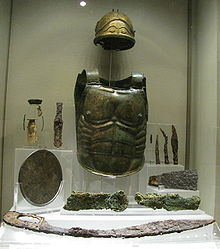Lanuvium
 Map of comune of Lanuvio within Lazio | |
| Alternative name | Lanuvio |
|---|---|
| Location | Comune di Lanuvio |
| Region | Lazio |
| Type | Settlement |
| History | |
| Periods | Roman Republic Roman Empire |
| Cultures | Ancient Rome |
| Site notes | |
| Excavation dates | yes |
| Public access | yes |
Lanuvium, modern Lanuvio, is an ancient city of Latium vetus, some 32 kilometres (20 mi) southeast of Rome, a little southwest of the Via Appia.[1]
Situated on an isolated hill projecting south from the main mass of the Alban Hills, Lanuvium commanded an extensive view over the low country between it and the sea.
History


According to legend, Lanuvium was founded by Diomedes, or by one Lanoios, an exile from Troy. The first documented traces of the settlement date from the 9th century BC and by the 6th century BC it was part of the Latin League.
The city warred against Rome at the battles of Aricia (504 BC) and Lake Regillus (496 BC), as well as in 383 and 341 BC, mostly with negative outcomes. Rome conquered Lanuvium in 338 BC; at first, its inhabitants did not enjoy the right of Roman citizenship, but acquired it later. In imperial times the city's chief magistrate and municipal council kept the titles of dictator and senatus respectively.
In the 11th c. the city became known as Civita Lavinia, a result of the confusion between it and ancient Lavinium.[2]
Cult of Juno

Lanuvium was especially noted for its rich and much venerated temple of Juno Sospes (Livy 8.14; Cic. Nat. D. 1.83; Fin. 2.63), from which Octavian borrowed money in 31 BC, and the possessions of which extended as far as the coast of the Mediterranean.[3][4] It possessed many other temples repaired by Antoninus Pius, who was born close by (S. H. A. Ant. Pius 1), as was Commodus.
Prominent citizens
One prominent native of Lanuvium was Lucius Licinius Murena (consul of 62 BC), whom Cicero defended in late 63 BC. Others include the actor Roscius (Cic. Div. 36), the political agitator Titus Annius Milo, who was convicted for the murder of Clodius (Cic. Mil. 27) and Publius Sulpicius Quirinius, consul of 12 BC and later legate of Syria.
Monuments

Remains of the ancient theatre and of the city walls exist in the modern town, and above it is an area surrounded by a portico, in opus reticulatum, upon the north side of which is a rectangular building in opus quadratum, probably connected with the temple of Juno where archaic decorative terracottas artifacts have been found. The acropolis of the primitive city was probably on the highest point above the temple to the north. The neighborhood, which is now covered with vineyards, contains the remains of many Roman villas, one of which is traditionally attributed to the Emperor Antoninus Pius.[5]
References
- ^ Quilici, L., S. Quilici Gigli, DARMC, R. Talbert, S. Gillies, T. Elliott, J. Becker (6 May 2021). "Places: 422956 (Lanuvium)". Pleiades. Retrieved December 11, 2014.
{{cite web}}: CS1 maint: multiple names: authors list (link) - ^ Stillwell, Richard (1976). The Princeton Encyclopedia of Classical Sites. Princeton: Princeton University Press. Retrieved 15 December 2019.
- ^ Manlio Lilli (2001). Lanuvium: avanzi di edifici antichi negli appunti di R. Lanciani [Lanuvium: remains of ancient buildings in the notes of R. Lanciani]. L'ERMA di BRETSCHNEIDER. ISBN 978-88-8265-151-0.
- ^ Eric Orlin Professor of Classics University of Puget Sound (30 July 2010). Foreign Cults in Rome: Creating a Roman Empire. Oxford University Press, USA. pp. 125–. ISBN 978-0-19-978020-4.
- ^ R. Neudecker, Die Skulpturenausstattung römischer Villen in Italien (Mainz 1988) 164 ff. Cat. no. 22
- This article incorporates text from a publication now in the public domain: Chisholm, Hugh, ed. (1911). "Lanuvium". Encyclopædia Britannica. Vol. 16 (11th ed.). Cambridge University Press. p. 188.
